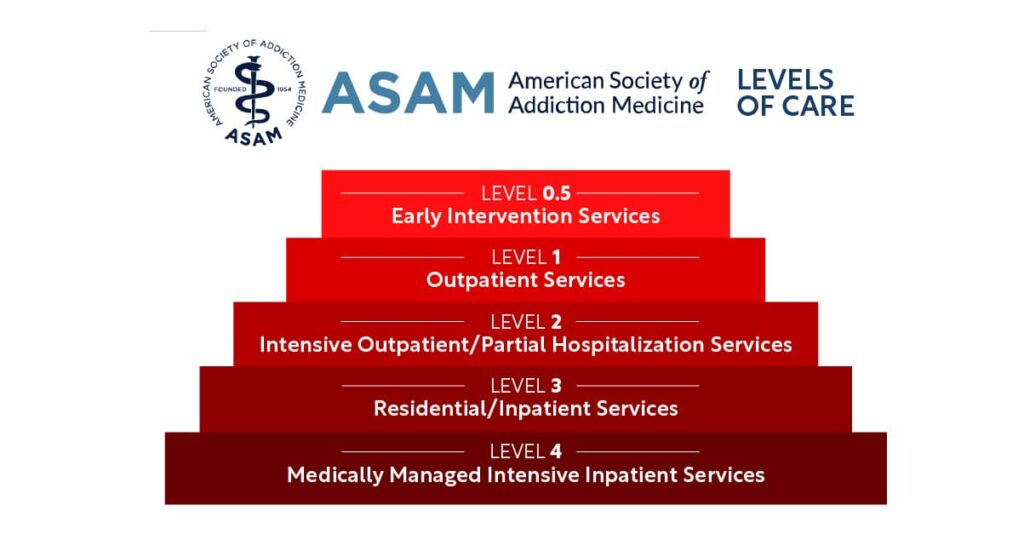It’s not easy for someone to admit they are struggling with a substance use disorder. It takes a lot of courage to ask for help. Deciding to enter a treatment program for help takes tremendous strength. One of the most difficult challenges in the entire addiction recovery journey is taking that first step.
But what happens next? How does a person start the path to recovery and achieve a sober, happy, healthy lifestyle?
While it may seem like a substance abuse treatment plan would be the same for everyone, everyone requires a customized plan. There are several types of short term and long term treatments and levels of care. Individuals can decide what is best for them when they know what each addiction treatment service consists of.
Find the location that works for you.

How Does a Treatment Center Determine the Levels of Care for Substance Abuse Recovery?
The pre-assessment process typically determines the levels of care for drug and alcohol recovery. During the assessment, specialists gather information that helps understand your substance use disorder. In doing so, they can make an informed decision about your treatment plan.
During the assessment, intake counselors may ask some of the following questions.
- Have you taken part in a treatment program before?
- How often are you using drugs or alcohol? How much are you using?
- Do you have an official mental health diagnosis?
- Does your family have a history of mental health conditions?
- Do you have any medical issues?
- Do you take any medications?
Admissions specialists only ask these questions to help guide your treatment plan. Even though a pre-assessment is comprehensive, there are various factors that ultimately influence treatment recommendations.
Learning the tools to achieve a sober life begins once the treatment center completes your assessment.
Levels of Care for Substance Abuse Recovery
The goal of care levels is to ensure each person receives the appropriate care immediately upon admission. From there, they can smoothly transition to the next levels in the treatment process. An individual may be moved to a higher or lower level of care depending on how they meet specific goals they’ve created with their treatment provider.
The first step on the path to recovery is to make that initial phone call and set up an appointment with a substance use treatment center. After the addiction recovery program staff complete an evaluation, together you will decide your optimal level of care.
The American Society of Addiction Medicine (ASAM) created a specific continuum of care for United States rehab programs. This guides a person through the recovery process as smoothly and successfully as possible.
The five core levels of care include the following.
- Level 0.5: Early Intervention Services
- Level 1: Outpatient Services
- Level 2: Intensive Outpatient/Partial Hospitalization Services
- Level 3: Residential/Inpatient Services
- Level 4: Medically Managed Intensive Inpatient Services

Level 0.5: Early Intervention Services
This first level in the continuum of care focuses on intervention by targeting individuals at risk of developing a substance dependence. In addition, Level 0.5 aims to assist those who show symptoms and signs of a substance addiction but may not meet the specific criteria to diagnose.
Early intervention identifies specific risk factors that may lead to a substance use disorder. The following are the most common risk factors to look out for:
- Minimal to no parental supervision
- Poor social supports and relationships
- Aggressive childhood behavior
- Access to substances such as drugs or alcohol
Early intervention can prevent a full-blown addiction from developing later down the road. For more information, call Zinnia Health at (855) 430-9439.
Level 1: Outpatient Services
Outpatient rehab best suits those who are struggling with drug or alcohol use, can maintain their day-to-day lives, but still require treatment.
Outpatient treatment programs typically require 9 hours of treatment per week (6 hours per week for adolescents). This drug recovery program includes meeting regularly with addiction professionals and doctors for recovery treatment.
A person can attend therapy, receive medication, and engage in additional drug addiction recovery programs. Outpatient rehab provides treatment at one of the lowest levels of intensity.
Sometimes, patients who can hold down a job or keep their family together need more help than they realize. They often suffer in silence because they can convince those around them that they are fine. Taking the first step to get help takes courage.
Level 2: Intensive Outpatient/Partial Hospitalization Services
Intensive outpatient programs and partial hospitalization programs (PHP) offer more intensive services and additional resources than other outpatient programs. Often one will spend more time in a therapeutic setting.
IOP and PHP are better options for individuals who need a higher level of treatment yet choose to live at home. Level 2 treatment further divides into sublevels 2.1 and 2.5.
Level 3: Residential/Inpatient Services
Residential addiction treatment programs or inpatient treatment programs provide around-the-clock treatment at an inpatient facility. You will typically live on-site or close to the treatment facility in this level of care.
Within Level 3, there are additional sublevels including the following.
- Level 3.1: Clinically Managed Low-Intensity Residential Services. Recovery skills are the primary focus of Level 3.1, including managing emotions and relapse prevention skills. At this level, a treatment center will provide at least five hours of clinical services each week. Structured atmosphere, 24/7 staff availability, outpatient services, life-skills building, and house meetings are some of the most common treatment services in Level 3.1.
- Level 3.3: Clinically Managed Population-Specific High-Intensity Residential Services. The Level 3.3 treatment program is also referred to as long-term care or extended care. It offers a structured atmosphere with medium-intensity clinical services. This type of recovery treatment is for individuals with substance or alcohol use disorders whose lives have been severely impacted by substance abuse.
Level 3.3 offers treatment at a slower pace, focusing on repetition to guide a person back into a healthier, drug, and alcohol-free lifestyle. This level offers ongoing case management, housing, transportation, vocational needs, support systems, and access to self-help meetings. - Level 3.5: Clinically Managed High-Intensity Residential Services. The Level 3.5 treatment program is for individuals with multiple needs, such as a severe functional impairment, co-occurring disorders, or are struggling to adjust to a healthy routine.
- Level 3.7: Medically Monitored Intensive Inpatient Services. The Level 3.7 treatment program is the highest intensity Level 3 service. This recovery treatment is for people with substance use disorders and medical and/or emotional issues, or withdrawal risks that serve as roadblocks in their recovery progression.
Level 4: Medically Managed Intensive Inpatient Services
Level 4 is the most comprehensive and highest treatment level. This level incorporates 24-hour medical care, medically-assisted treatment, and evaluation, including meeting with a doctor daily. Facilities that offer Level 4 treatment may be psychiatric hospitals, which all provide substance abuse treatment and co-occurring disorders treatment.
This stage of the continuum focuses on ensuring a person will be ready to enter a less intensive care level in their journey toward recovery.
PHP or IOP—Which is better for your recovery journey?
Once your Levels of Care for Substance Abuse Recovery are determined, you’ll either be placed in a Partial Hospitalization Program (PHP), Intensive Outpatient Program (IOP), or another level of care. If you have questions or wish to seek treatment, call Zinnia Health at (855) 430-9439.
Partial Hospitalization Program (PHP)
PHP, sometimes known as day treatment, has an intensive level of outpatient treatment that provides a solid foundation for your recovery. You will be able to live at home or in specified housing through the treatment center.
A PHP program can be a good next step when someone leaves a residential program. PHP is also a good option for people who can keep up with their day-to-day life but are still struggling with addiction.
Partial Hospitalization Programs provide access to top-notch medical staff and mental health professionals in a safe environment while allowing you to retain your independence. The program also reinforces skill sets and strategies for helping patients deal with real-world scenarios during recovery.
Intensive Outpatient Program (IOP)
An intensive outpatient program is a good option for anyone who still requires treatment but also has familial, professional, and financial obligations to uphold. The IOP helps you build a sense of accountability with education and therapy. Depending on the facility, there may be options for family therapy and 12-step programs.
There is a focus on teaching and reinforcing the necessary skills to avoid relapse and how to recognize and cope with triggers.
Continuum of Care for Individuals with Substance Use Disorders
The continuum of care is a guideline for recovery treatment to help address that neither addiction nor recovery is linear, meaning they don’t follow a straight line. It helps caregivers decide the best treatment for each individual. It allows the focus to be on a person’s changing needs, which is vital to creating a path to recovery.
With evidence-based treatment, addiction professionals can utilize proven treatment methods and thus improve long-term recovery chances.
To learn more about our addiction treatment programs, call Zinnia Health at (855) 430-9439.

